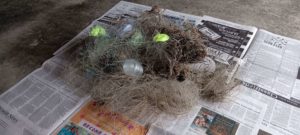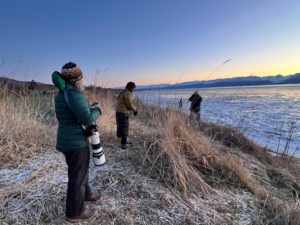KACHEMAK BAY BIRDERS
***TRIPS/Events
Spit Trip Report: 11-15-25
KBB Bird Walk Results – November 15, 2025 from Dave Erikson
The Kachemak Bay Birders conducted its last bird walk of the year this past Saturday,
November 15, from 10:00 AM until noon. The walk began at the base of the Homer Spit
and covered much of the west side of the Homer Spit, the Homer Harbor, and the open
water areas in front of Land’s End Resort. The weather was clear, the tide was high and
the winds were calm. Ideal conditions for birding this time of year!
A total of fourteen birders participated in the walk, including two from the Soldotna area
who heard about the event and made the trip down the highway.
The highlights of walk included a lone short-eared owl that flew right in front of the group
at the beach at Mariner Park with the sun to its back illuminating its beautiful feathers.
Also, a lone shearwater seen off Land’s End feeding with the kittiwakes. Shearwaters
are typically migrating to their breeding grounds in the Australia and New Zealand by
this time of year. Several more shearwaters were seen in the same general area during
the afternoon following the walk.
A total of 28 species and nearly 800 individuals were documented during the two-hour
walk:
Surf Scoter – 20
Black Scoter – 88
White-winged Scoter – 19
Long-tailed Duck – 3
Bufflehead – 7
Common Goldeneye – 1
Red-breasted Merganser – 1
Ring-necked Pheasant – 1
Rock Pigeon – 115
Rock Sandpiper – 250
Marbled Murrelet – 4
Pigeon Guillemot – 3
Common Murre – 1
Black-legged Kittiwake – 10
Short-billed Gull – 4
procrastinated on reporting!) at 8:00pm, at Homer Reservoir. A couple of
us got there a bit early and were greeted by a Great Horned Owl calling
in the distance. Eventually we were joined by three more intrepid
birders. However a very light mist built to an actual light rain in the
next 30 minutes. We called all three expected owl calls and got no
response. Owls do not fly in the rain because their feathers are not
waterproof, so likely reason.
After 30 minutes of hearing nothing, getting wet and common sense
prevailing, we gave it up.
Next year!
Gary Lyon
Last Saturday morning, September 20th , the Kachemak Bay Birders sponsored its
monthly bird walk at Mossy Kilcher’s Seaside Farm, located approximately Mile 5 East
End Road in Homer. Seaside Farm is one of the unique birding hotspots in the Homer
area. Open fields and extensive landscaping create a great place to find passerines and
other land birds. Access to the tidal flats of Kachemak Bay also makes it a great place
to look for marine-oriented birds.
Birders met at 8:00 AM, just after sunrise. Fog, light rain and low light levels made for
poor visibility around the farm, but a few birds were located in the trees and shrubs after
it got a little lighter. However, most bird activity was found near some of the many bird
feeders on the farm.
A trip down to the shoreline of Kachemak Bay yielded a few additional species. The tide
was low, so extensive mudflats were exposed in front of the bluff. Mallards were
observed feeding at the water’s edge and flying low over the flats. Bald eagles were
seen perching on boulders along the outer limits of the flats. Song sparrows were found
in the beach grass at the edge of bluff. Fox sparrows were seen and head in the mixed
forest and shrub habitats on the path down to the beach.
A total of ten species were documented during the two-hour walk:
Mallard – 200+
Bald eagle – 4
Black-capped chickadee – 3
Ruby-crowned kinglet – 3
Fox sparrow – 2
Dark- eyed junco – 1
Golden-crowned sparrow – 2
Song sparrow – 3
Orange-crowned warbler – 1
Yellow warbler – 1


